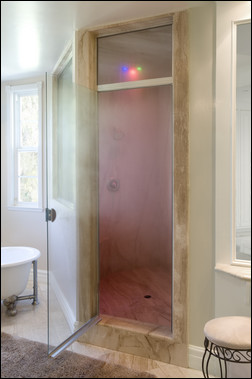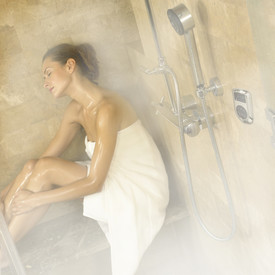The healing and relaxing effects of steam can be easily enjoyed in the comforts of one’s home. With the steam shower and steam bath kits available from dozens of manufacturers, an ordinary shower enclosure can be transformed into a spa for as little as $2,000. These systems are digitally controlled, quickly installed and calibrated for a consistent, pleasant steam experience to rival any health club sauna—all in the privacy of the home bathroom.
 ThermaSol’s Serenity Light and Music System at work during a steam shower session. Photo courtesy of ThermaSol. |
Steam’s Healthy History
Humans have enjoyed the health and wellness benefits of steam for many centuries. Although the first uses of steam by humans is in dispute, steam baths, spas and saunas were used by the ancient Greeks, Romans and Aztecs and later by the Turks and Russians. In modern times, the steam experience has been largely limited to hotels, health clubs and spas. As the trend of investing in the bathroom remodel and spa experience grew, residential spa fixtures like the jetted tub and shower tower massage units became more accessible and affordable to the average homeowner. The steam shower and steam bath systems are another product line in a series of residential bathroom upgrade options designed to transform the bathroom into a private spa.
“It’s like a full-body facial,” says Mitch Altman, CEO of ThermaSol, manufacturers of steam shower systems and products, describing the effects of a steam shower or bath. In a steam shower, steam that is heated to anywhere from 110 to 120 degrees F is sent from a steam generator to a steam head mounted on a wall within an enclosure. The enclosure is filled with hot steam, which increases circulation, releases toxins, increases caloric consumption, de-stresses and relaxes. Unlike a sauna—which operates at 175 to 190 degrees F in up to 35 percent humidity—the steam room experience occurs at 100 percent humidity and lower temperatures, which keeps the skin hydrated and supple.
Steam System Packages
Most basic steam shower or steam bath systems include the steam generator, a steam head (much like a shower head) and a control device. The steam generator runs on electricity (208, 220 or 240V is common) and connects to the home water supply. Piping runs from the generator to the steam head, which is mounted in a hole on the shower enclosure wall. The steam generator is connected by wire to the control device, which is also commonly mounted inside the shower enclosure. These three parts—generator, steam head and controls—comprise the basic steam shower or steam bath package available from manufacturers.
Accessories
The basic steam system package has a few attractive upgrade options. Like the modern bathroom—which can be accessorized in countless ways by countless products—added features and devices can bolster the steam system. In addition to the basic generator, steam head and control device, steam system options can include aromatherapy features, chromotherapy fixtures and speaker systems aimed at incorporating all the senses into the overall bathroom spa experience.
The aromatherapy feature can be incorporated into the steam shower or steam bath system in a couple ways. The manual approach enables the user to apply a few drops of essential oils to a built-in reservoir on the steam head. When the system is turned on, the steam head heats up, vaporizing the oils and mixing it with the steam. Automatic units can be purchased and installed alongside or near the generator. These units can hold larger quantities of oil, are controlled by the wall-mounted control device and inject oil into the steam before it comes to the steam head.
Chromotherapy options usually come by way of a ceiling-installed lighting fixture that can bathe the user in any combination of soothing colors. “Our chromotherapy includes mood lighting, white light, and color combinations for the seven chakras,” says Altman. “Each color combination is set for the soothing of a particular body part.”
Incorporating music and sound therapy is a newer feature to be included in the steam shower and steam bath package. ThermaSol’s speaker system is built into the overhead chromotherapy lighting fixture, whereas other companies like Mr. Steam offer two-way, flush-mounted, moisture-resistant speakers that install separately into the shower enclosure ceiling. The speaker systems can wire directly to any number of external sound sources, including the cable box for digital music channels or an iPod docking station.
 A ThermaSol steam session programmed through a digital control. Photo courtesy of ThermaSol. |
Consumers should pay close attention to the control features of any steam shower or steam bath package. Digital displays are de rigueur, but bells and whistles like talking controls, remote controls and personalized steam session memory features can set one brand apart from the rest.
Cost
Of course, the more accessories added, the greater the cost. Still, a basic package (generator, steam head, controls) can start at just under $2,000, depending on the manufacturer. “Most dealers and Internet distributors will work with you on ensuring that you get the right unit for your shower at a great price,” says Mike Pinkus, senior vice president of Mr. Steam, a division of Sussman-Automatic Corp. and manufacturers of residential and commercial steam room systems. Mr. Steam’s residential product line features two styles for the exposed control, steam head and chromotherapy pieces, as well as a variety of finish options to match the existing fixtures and hardware pieces in the bathroom.
By tacking on overhead chromotherapy fixtures, speakers and aromatherapy options, the homeowner can be looking at $7,000 to $8,000 for the uninstalled system, depending on the generator size.
Steam is Green
One of steam’s highly touted benefits is its environmentally friendly characteristic. “A 20-minute steam session with an average-sized generator only consumes about two gallons of water,” says Pinkus. Compared to the water usage in a single whirlpool or spa tub use, the steam shower gains the green edge. Even the small heater incorporated into the ThermaSol generators—which keeps the water at a high temperature for rapid steam delivery—only uses “as much power as a clock radio,” says Altman. For the homeowner looking for a spa experience that conserves water, the steam shower or steam bath is a guilt-free option.
Important Considerations
There are a number of considerations a consumer will have to make to determine if a steam shower or bath system is right for the home. When not properly enclosed, steam can escape and spread, causing immediate and long-term moisture issues. The enclosure in which the steam shower system is to be installed should seal tightly when the entry door is closed. “In many shower enclosures, the homeowner may have to bring the door all the way to the ceiling,” says Altman.
Additionally, the materials used within the enclosure will be exposed to heated steam, so consumers will need to check with manufacturers to determine if the materials will stand up to these conditions. “Some resin-based or synthetic materials might not be compatible with steam,” says Pinkus. “Materials like tile and natural marble are tried-and-true materials, and they are ideal for the steam room.” Some manufacturers recommend that the walls, ceiling and floor of a steam room be completely covered in a waterproof finish such as tile or marble.
Steam generators are sized by the kilowatt (kW), which correlates to steam output. Most manufacturers will have a sizing chart to help consumers correctly determine the steam generator for their home. Total volume of the room to be filled (length x width x height) is the main consideration, but some manufacturers will also ask for information concerning the material of other features in the enclosure, such as the bench or the tiling. “Certain materials absorb more heat energy than others,” Pinkus explains.
Installation
Manufacturers of steam shower and steam bath systems each have specific installation guidelines, and a consumer will want to study these carefully to determine which system is right for the home. Some important considerations may include:
• Maximum distance between the steam generator and the steam head
• Line voltage requirements for the generator
• Steam head location specifications, such as minimum height requirements from the floor or minimum distance from the steam room bench.
 |
||||
|
||||
Installation will require an electrician and a plumber for wiring power and for connecting the steam generator to the water supply as well as the steam head. “Our plumbing connections are common NPT (National Pipe Thread),” says Pinkus, “so the plumber can use standard parts.”
The steam shower and steam bath experience brings the luxury of the health spa into the home without the bank-breaking costs of a whirlpool tub or total bathroom renovation. This healthy, relaxing, water-conserving bathroom addition can be installed with little fuss, bringing the long-regarded benefits of steam home.
Credit: Renovate Your World




























